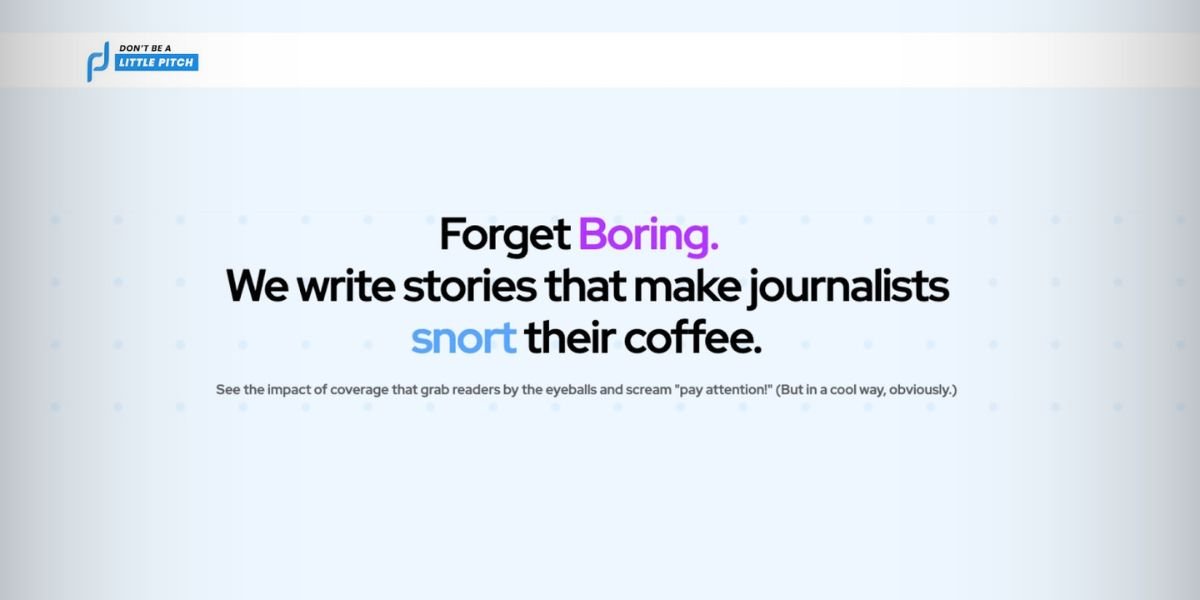How We Turn “Meh” Moments into A+ Features
By: Kate Sarmiento
The PR Playbook You Didn’t Know You Needed (But Definitely Do)
You’ve been there.
You launched a new product. You got a decent customer review. You hired someone cool. Maybe you even moved offices or hit 10K followers.
It’s not headline stuff, right? Or… is it?
At Don’t Be A Little Pitch (DBALP), we’ve made a habit (and a business) out of turning those so-called “meh” moments into media catnip. While most brands sit on small updates, thinking, “This isn’t news,” we say: “Watch this.”
Because the truth is, most coverage gold isn’t mined from groundbreaking launches or celebrity endorsements. It’s carved out of the everyday… if you know how to tell the story right.
What Even Is a “Meh” Moment?
Let’s clarify. A “meh” moment isn’t meaningless. It just hasn’t been packaged properly.
Here are a few examples of what most brands underestimate:
- A behind-the-scenes process
- A product restock (yes, really)
- A quirky founder habit or ritual
- A small but loyal customer base
- An anniversary or “birthday” of the company
- A new colorway or product tweak
In your mind, it’s easily overlooked. But to the right editor, it’s a trend, a hook, a “did you know?” line buried in a bigger story.
According to a Muck Rack State of PR 2023 report, 73% of journalists say the biggest reason they ignore a pitch is because “it’s not relevant to their beat.” Not because it’s boring, but because it wasn’t framed in a way that connected to what they care about. That’s a storytelling issue. And that’s fixable.
How We Spin “Meh” into Media Magic
We don’t rely simply on gimmicks and hope for the best. We look at what’s already happening inside your brand, then build a real story around it, one that makes sense in the current media landscape.
1. Tie It to a Trend
Your CEO’s morning routine isn’t news until we frame it under “How Startup Founders Hack Focus in 2025.”
A product restock might feel like business as usual. But if it speaks to rising demand, it becomes part of a larger conversation.
We constantly scan what editors are covering, which headlines are gaining traction, and what audiences are responding to. Then we find the most natural connection point between your brand and what’s trending.
2. Add Expert Weight
We don’t just pitch updates. We pitch takes.
By attaching your brand’s POV to a broader conversation (AI, sustainability, slow fashion, workplace culture), we create relevant storylines that matter to editors and audiences alike. Even better? We draft pitches in your brand’s voice so editors don’t feel like they’re reading the same email for the 100th time.
3. Build a Visual & Emotional Hook
A strong visual, a clever turn of phrase, or a simple metaphor that hits home can stop an editor mid-scroll.
Humor? Still works. Relatability? Always wins. A quote that actually sounds like something a real human said? That’s the gold standard.
When it lands right, a small story becomes a big opportunity.
From Quiet Wins to National Headlines: How You Can Do It Too
Not everyone has a full PR team. But the mindset? That’s free. And the method? Proven.
Take Carved, a wood-and-resin phone accessory brand that came to us with one clear goal: national media coverage to boost brand visibility and sales.
Sounds like a tall order in a saturated market, right?
Spoiler: they landed features in Forbes, CNET, 9to5Mac, The Verge, and dozens more. And it started with what many would’ve dismissed as a minor update: handcrafted phone cases.
The product was great. The team was talented. But the story? That’s what we built.
We didn’t lead with “phone case.” We led with:
“Art you can hold. Handcrafted from the real landscapes of the planet. Every swirl, every grain, one of a kind… just like the person holding it.”
Then we layered:
- Custom pitches in the voice of Carved’s founder
- A gift strategy that wasn’t transactional, but experiential
- Media lists targeting tech, lifestyle, gifting, and niche outlets
- Follow-ups that didn’t feel like spam, they felt like human curiosity
The results?
- 88 pieces of coverage (and counting)
- A 78 percent email open rate and a 15 percent response rate
- A 23 percent increase in monthly traffic
- Exposure to 100 million-plus eyeballs via national and niche outlets
All because we didn’t wait for a big news moment. We built one. And that’s exactly what founders and marketers can do in-house, starting today. Here’s how:
Audit your last 30 days. What changed? What did you almost post to LinkedIn and then second-guess?
Ask, “What’s the story behind this?” Not just what happened, but why. And why now?
Match the moment to a movement. Is there a trend you can align with? A bigger wave to ride?
Find your spokespeople. Who on your team has a hot take? A personal story? A lived experience that connects to your update?
Stop waiting for perfect. Journalists want a good angle, not a flawless announcement. Done is better than invisible.
The difference between “meh” and media-worthy often comes down to framing, timing, and knowing how to connect the dots.
Carved didn’t change their product. They changed the way it was pitched. And that shift turned handcrafted accessories into national conversation starters.
You can do the same.
Let’s Make It Louder, Smarter, and Press-Ready
Brand gravity isn’t built on launches alone. It’s the momentum you build from showing up consistently and showing up with strategy.
At Don’t Be A Little Pitch (DBALP), we don’t wait for moments. We make them. We help brands turn quiet wins into bold headlines. Because the right pitch can make anything newsworthy.
Got a moment you think no one cares about? Let’s talk. We’ll make it louder. We’ll make it smarter. And we’ll make it press-ready.
Visit dontbealittlepitch.com and let’s build your media magic.




